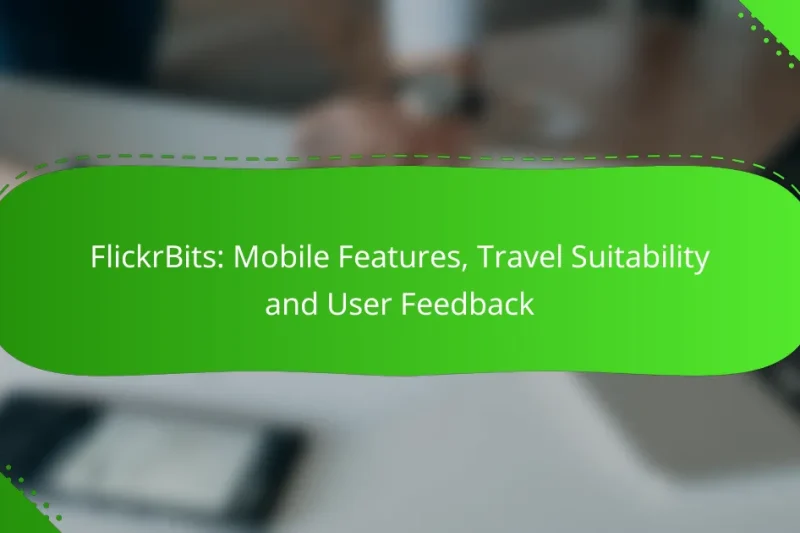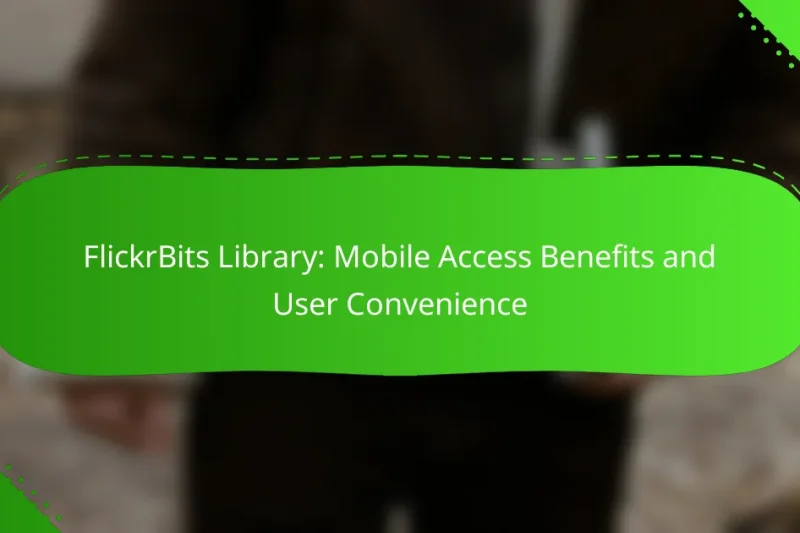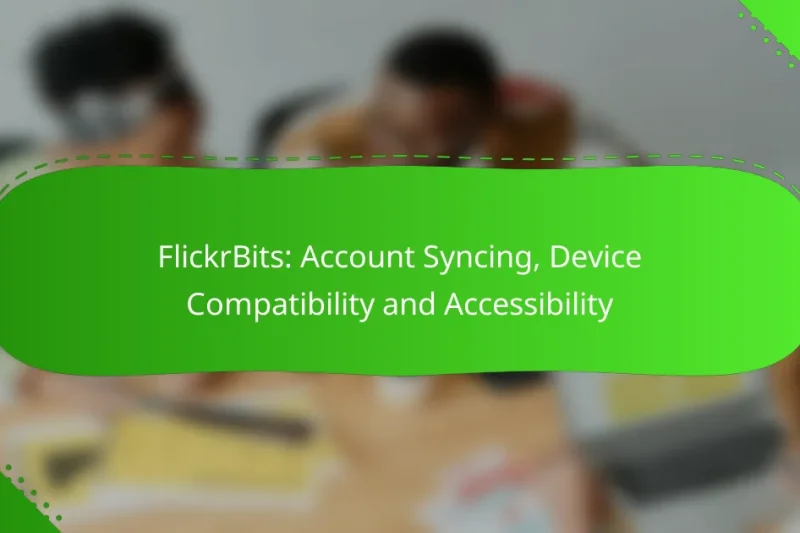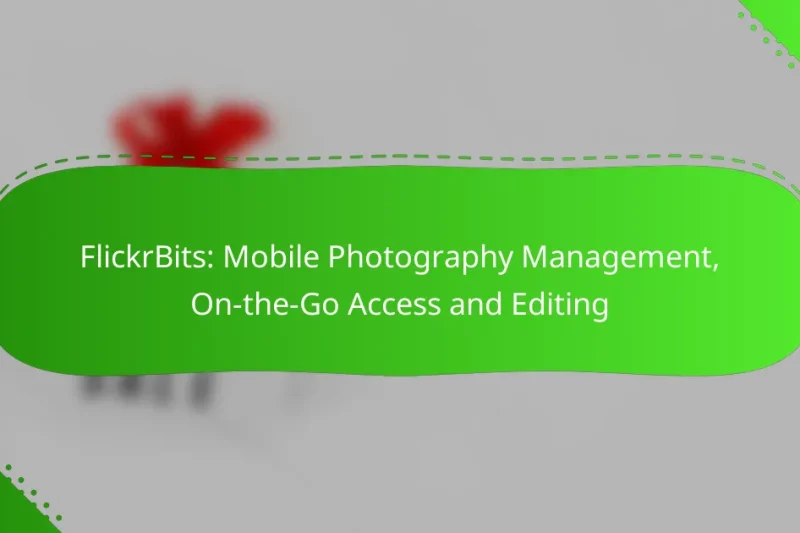FlickrBits revolutionizes mobile photography by equipping users with essential tools for editing, sharing, and organizing photos … FlickrBits: Mobile Features, Travel Suitability and User FeedbackRead more
FlickrBits Mobile Accessibility
FlickrBits is committed to enhancing mobile accessibility through a range of user-friendly features tailored to meet diverse needs. By implementing functionalities such as image alt text, adjustable color contrast, and text resizing options, the platform ensures that all users, including those with disabilities, can easily navigate and utilize its services on mobile devices.
FlickrBits Library: Mobile Access Benefits and User Convenience
Mobile access to the FlickrBits Library empowers users to manage their photo collections effortlessly, anytime and … FlickrBits Library: Mobile Access Benefits and User ConvenienceRead more
FlickrBits: Account Syncing, Device Compatibility and Accessibility
FlickrBits offers a seamless account syncing experience across multiple devices, allowing users to keep their photos … FlickrBits: Account Syncing, Device Compatibility and AccessibilityRead more
FlickrBits: Mobile Photography Management, On-the-Go Access and Editing
FlickrBits revolutionizes mobile photography management by equipping users with powerful tools for organizing, editing, and sharing … FlickrBits: Mobile Photography Management, On-the-Go Access and EditingRead more
How does FlickrBits enhance mobile accessibility?
FlickrBits enhances mobile accessibility by implementing user-friendly features that cater to diverse needs. These enhancements ensure that all users, regardless of their abilities, can navigate and utilize the platform effectively.
Responsive design features
The responsive design of FlickrBits adapts seamlessly to various screen sizes and orientations, providing an optimal viewing experience on smartphones and tablets. This flexibility allows users to access content without needing to zoom or scroll excessively.
Key elements of responsive design include fluid grids, flexible images, and media queries that adjust layout based on device specifications. This ensures that users can enjoy a consistent interface whether they are using a small smartphone or a larger tablet.
Keyboard navigation support
FlickrBits offers robust keyboard navigation support, allowing users to navigate the platform without relying solely on a touchscreen. This feature is particularly beneficial for individuals with mobility impairments who may find it challenging to use touch interfaces.
Users can access key functions through keyboard shortcuts, making it easier to upload photos, browse galleries, and manage settings. Ensuring that all interactive elements are reachable via keyboard enhances overall usability.
Screen reader compatibility
FlickrBits is designed to be compatible with screen readers, which are essential tools for visually impaired users. This compatibility ensures that all content, including images and descriptions, is accessible and can be interpreted by assistive technologies.
To improve screen reader experience, FlickrBits employs proper HTML markup and ARIA (Accessible Rich Internet Applications) attributes. This allows screen readers to convey information accurately, helping users navigate the platform effectively.
What are the key mobile accessibility features of FlickrBits?
FlickrBits offers several mobile accessibility features designed to enhance user experience for individuals with disabilities. Key functionalities include image alt text implementation, color contrast settings, and text resizing options, all aimed at making the platform more user-friendly.
Image alt text implementation
FlickrBits allows users to add descriptive alt text to images, which is crucial for visually impaired individuals using screen readers. This feature ensures that users can understand the content of images through audio descriptions. When uploading images, users should take care to provide clear and concise descriptions that convey the essential information.
To maximize the effectiveness of alt text, aim for a description length of 5-15 words, focusing on the image’s main subject and context. Avoid using phrases like “image of” or “picture of,” as these do not add value to the description.
Color contrast settings
FlickrBits includes adjustable color contrast settings to improve readability for users with visual impairments. Users can modify background and text colors to ensure sufficient contrast, which is vital for those with color blindness or low vision. A contrast ratio of at least 4.5:1 is generally recommended for normal text.
To test color combinations, consider using online contrast checkers. Users should aim for high-contrast color schemes that enhance text visibility without straining the eyes, especially in bright or dim lighting conditions.
Text resizing options
FlickrBits provides text resizing options that allow users to adjust font sizes according to their preferences. This feature is particularly beneficial for individuals with low vision who may require larger text for better readability. Users can typically increase text size by 125% to 200% without losing functionality or layout integrity.
When resizing text, ensure that the interface remains user-friendly and that all elements are accessible. Avoid using fixed sizes; instead, opt for relative units like ems or percentages to maintain flexibility across different devices and screen sizes.
How can users optimize FlickrBits for mobile accessibility?
Users can optimize FlickrBits for mobile accessibility by adjusting settings and utilizing features designed for better usability on smaller screens. This ensures that all users, including those with disabilities, can navigate and interact with the platform effectively.
Customizing accessibility settings
FlickrBits offers various accessibility settings that can enhance the user experience on mobile devices. Users should explore options such as text size adjustments, color contrast settings, and screen reader compatibility to tailor the interface to their needs.
To customize these settings, navigate to the accessibility section in the app’s menu. Regularly review these options, as updates may introduce new features that improve accessibility.
Utilizing mobile-friendly templates
Choosing mobile-friendly templates is crucial for ensuring that content displays well on smartphones and tablets. These templates are designed to be responsive, meaning they automatically adjust to different screen sizes, providing a seamless experience.
When selecting a template, look for features like larger buttons, simplified navigation, and clear typography. Avoid overly complex designs that may hinder usability, especially for users with visual impairments.
What are the best practices for mobile accessibility in SaaS tools?
Best practices for mobile accessibility in SaaS tools focus on ensuring that all users, regardless of ability, can effectively interact with the application. This includes adhering to established guidelines, conducting user testing, and implementing feedback to enhance usability.
Adhering to WCAG standards
Following the Web Content Accessibility Guidelines (WCAG) is crucial for mobile accessibility. These standards provide a framework for making web content more accessible to people with disabilities, covering areas such as text readability, navigational ease, and compatibility with assistive technologies.
Key principles of WCAG include perceivable, operable, understandable, and robust content. For instance, using sufficient color contrast and providing text alternatives for images can significantly improve accessibility for users with visual impairments.
Regular user testing with diverse groups
Conducting regular user testing with a diverse range of participants is essential for identifying accessibility issues. This should include users with various disabilities, as well as those using different devices and operating systems, to gather a broad spectrum of feedback.
Consider implementing usability testing sessions where participants can interact with the mobile application while sharing their experiences. This approach helps uncover specific barriers and informs necessary adjustments to improve overall accessibility.
How does FlickrBits compare to other mobile accessibility tools?
FlickrBits stands out among mobile accessibility tools by offering a user-friendly interface and robust features tailored for photographers. While it excels in photo organization and sharing, its capabilities may differ significantly from other popular tools like Adobe Lightroom and Canva.
Comparison with Adobe Lightroom
Adobe Lightroom is a powerful tool known for its advanced editing features and extensive photo management capabilities. While FlickrBits focuses on accessibility and ease of use, Lightroom provides more in-depth editing options, making it ideal for professional photographers who require detailed adjustments.
In terms of mobile accessibility, FlickrBits offers a simpler interface that allows users to quickly upload and share images. However, Lightroom’s mobile app includes features like RAW editing and cloud syncing, which may appeal to users looking for comprehensive editing on the go.
Comparison with Canva
Canva is primarily a design tool that allows users to create graphics and layouts, making it different from FlickrBits, which is focused on photo sharing. While Canva offers templates and design elements, FlickrBits excels in organizing and showcasing photography.
For users who want to create visually appealing posts for social media, Canva may be more suitable due to its extensive design features. However, if the goal is to manage and share a photography portfolio, FlickrBits provides a more streamlined experience tailored to that specific need.
What are the future trends in mobile accessibility for SaaS?
Future trends in mobile accessibility for Software as a Service (SaaS) are increasingly focused on integrating advanced technologies and enhancing user experience. As regulations evolve and user expectations rise, companies are prioritizing accessibility features that cater to diverse needs.
AI-driven accessibility enhancements
AI is transforming mobile accessibility by automating features that adapt to user preferences and needs. For example, machine learning algorithms can analyze user behavior to provide personalized content and navigation options, making applications more intuitive for individuals with disabilities.
Additionally, AI tools can assist in real-time captioning and voice recognition, improving communication for users with hearing impairments. Companies should consider implementing these technologies to stay competitive and compliant with accessibility standards.
Increased focus on user experience
As mobile accessibility becomes a priority, there is a growing emphasis on user experience (UX) design that accommodates all users. This includes simplifying navigation, ensuring readability, and providing alternative text for images, which can significantly enhance usability for individuals with disabilities.
To achieve this, companies should conduct regular user testing with diverse groups, including those with disabilities, to gather feedback and make necessary adjustments. Prioritizing UX not only meets legal requirements but also fosters customer loyalty and satisfaction.



